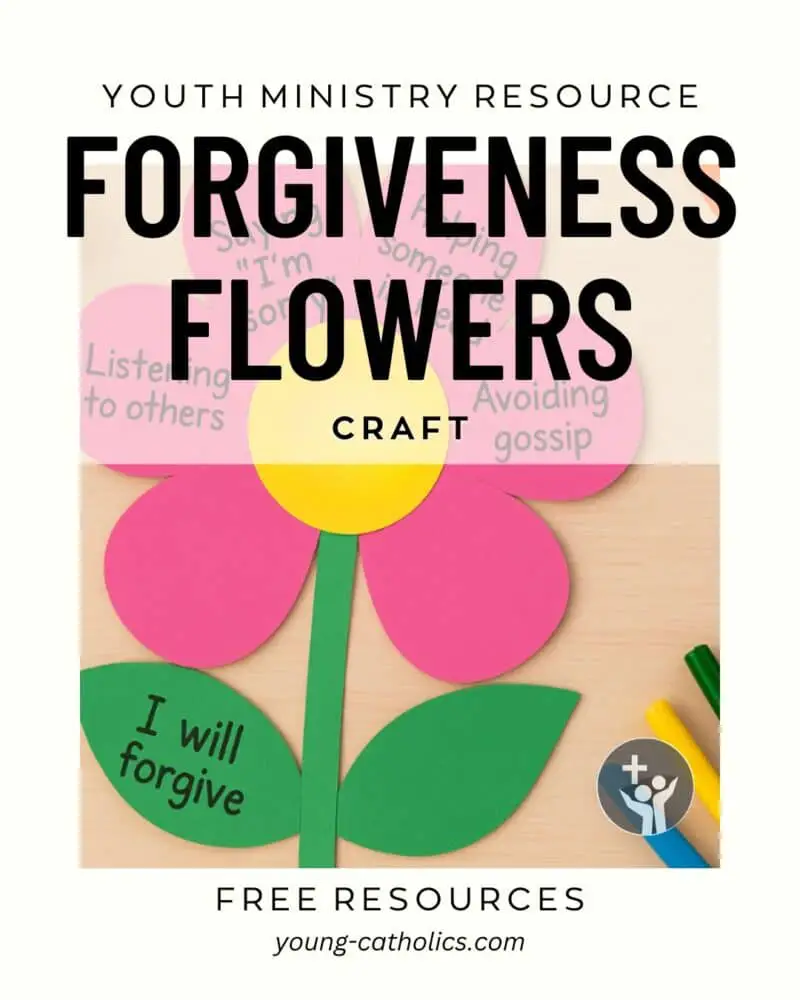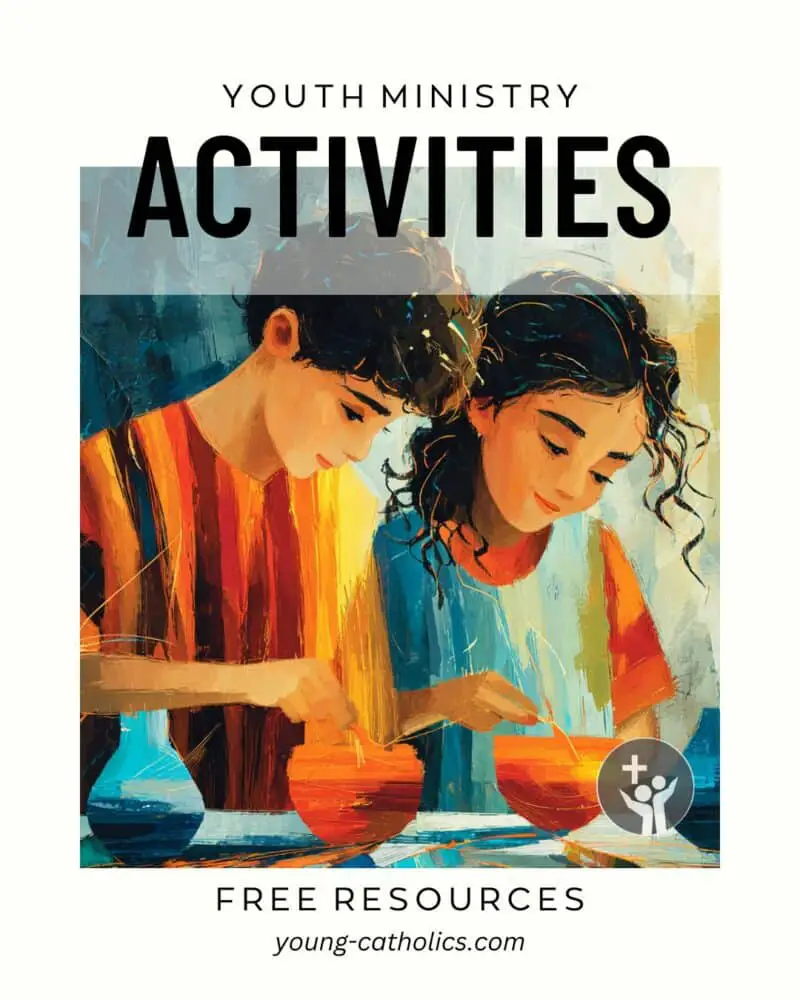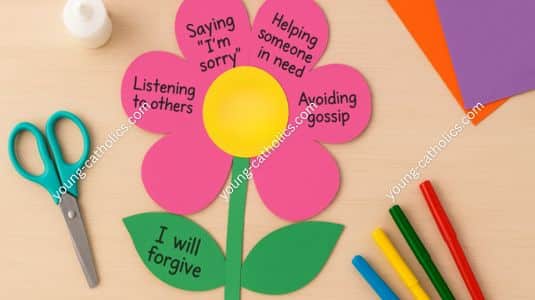Forgiveness Flowers Craft

Forgiveness is not always easy for young people to understand. They may feel hurt or angry when friends or family members disappoint them. At the same time, they also make mistakes and need to ask others for forgiveness.
Learning how to forgive and be forgiven is an important part of growing in faith and building strong relationships. The Forgiveness Flowers activity gives children a chance to practice this lesson in a simple and creative way.
This activity helps youth see forgiveness as something active, not just a word to say. By writing down ways they can forgive or be forgiven, they begin to think about their own choices and actions.
It moves the idea of forgiveness from something abstract to something they can live out in daily life. It also helps them understand that forgiveness brings healing and peace, both for themselves and for others.
The project also encourages sharing and listening. As children talk about what they wrote on their flower petals, they learn from one another. They may discover new ways to handle conflict or be reminded that others face the same struggles they do. This creates an environment of trust and support where forgiveness is valued and practiced together.
Finally, the Forgiveness Flowers activity connects faith with action. It ties the message of Scripture, such as the parable in Matthew 18, to something children can hold in their hands. When they see their flower, they remember that God calls us to forgive, just as He forgives us. The craft becomes a lasting reminder that forgiveness is not only possible but also a gift that helps us grow closer to God and one another.
Forgiveness in Action
Forgiveness Flowers can be closely tied to the teachings of Jesus in the Bible. In Matthew 18, Peter asks how many times he should forgive, and Jesus answers that forgiveness has no limit. This shows that forgiveness is a constant part of Christian life. When children create their flowers, they are reminded that forgiveness is not just about saying the right words. It is about living out what Jesus taught in real and simple ways.
In Catholic catechesis, forgiveness is also connected to the sacraments. Reconciliation teaches us to admit our sins, say we are sorry, and receive God’s mercy. The Forgiveness Flowers activity helps children see how this practice extends into daily life. It makes the idea of reconciliation something they can act on with friends, family, and others. It brings the lessons of faith from the classroom into their hearts and actions.
In youth ministry, this activity encourages both reflection and community. As young people share their petals, they learn from one another’s ideas and experiences. They see that everyone struggles with forgiveness but also that everyone can grow in it. This builds a stronger group that is rooted in kindness, patience, and understanding. It turns catechesis into a lived experience, where faith is practiced through love and mercy.
Forgiveness Flowers Activity Instructions
Materials Needed
- Construction paper (various colors)
- Scissors
- Glue sticks
- Markers or crayons
- Pencils
- Optional: flower template (printable)
Instructions
- Give each child a piece of construction paper. Have them draw or trace a flower with five or six petals.
- Ask the children to cut out the flower shape carefully.
- On each petal, have them write or draw one way they can forgive others or ask for forgiveness.
- Using green construction paper, help them cut out a stem and leaves.
- On the leaves, have them write a personal promise about forgiveness.
- Glue the petals to the flower center. Attach the stem and leaves.
- Allow the children to decorate their flowers with colors and designs.
- When finished, invite them to share some of their petals with the group.
- End with a short reflection or prayer on forgiveness.
Examples for the Petals
- Saying “I’m sorry”
- Listening to others
- Helping someone in need
- Giving a second chance
- Writing a note of apology
- Hugging or shaking hands
- Spending time together
- Avoiding gossip
- Praying for someone
- Reflecting on my actions
- Being patient
- Smiling and being friendly
Notes and Variations
- Younger children can draw pictures instead of writing words.
- Older children can write longer sentences or short prayers.
- Create a group display called a “Garden of Forgiveness Flowers.”
- Always remind children to use scissors safely and help those who need assistance.
Forgiveness Flowers Lesson
Lesson Goal
Children will learn that forgiveness is a way to show love. They will see how Jesus teaches us to forgive. They will make Forgiveness Flowers to remind them to be kind and forgiving.
Age Group
Kindergarten–Grade 2
Time Needed
30–40 minutes
Supplies
- Construction paper (bright colors)
- Scissors (safety scissors for young children)
- Glue sticks
- Crayons or markers
- Pencils
- Optional: simple flower template (printable)
- Bible (for Matthew 18:21-22)
Lesson Outline
- Opening Prayer (3 minutes)
Pray: “Dear Jesus, thank you for forgiving us. Help us to forgive others too. Amen.” - Scripture Story (5 minutes)
Read Matthew 18:21-22 in simple words. Say: “Jesus tells us to forgive many times. God forgives us, and we should forgive too.” - Talk Time (5 minutes)
Ask:- What does it mean to forgive?
- How do you feel when someone forgives you?
- How do you feel when you forgive a friend?
Keep answers short and simple. Affirm their ideas.
- Forgiveness Flowers Craft (15 minutes)
- Help children trace or cut out a flower with 5 petals.
- On each petal, they can draw or write one way to forgive.
- Add a stem and leaves. On a leaf, write “I will forgive.”
- Glue and color the flower.
- Share Together (5 minutes)
Invite a few children to show their flowers. Ask them to say one petal idea. - Closing Prayer (2 minutes)
Hold up the flowers and pray: “Jesus, thank you for teaching us to forgive. Help us to love others like you love us. Amen.”
Adaptations
- In Children’s Liturgy of the Word, use only the short Scripture and a quick craft.
- In Vacation Bible School, display all flowers together on a wall as a big garden.
- In religious education, send the flowers home so families can talk about forgiveness together.
Resources

More Youth Ministry Activities
If you are looking for more ways to engage young people in faith, visit our youth ministry activities page. You will find games, crafts, discussions, and lessons that connect faith to real life. These activities are simple to use and can be adapted for different groups and ages. They help children and teens grow in their faith while also building friendships and trust.
Our youth ministry activities page is a helpful resource for catechists, teachers, parents, and leaders. It offers ideas that make learning about God fun and meaningful. Whether you need a quick icebreaker, a seasonal lesson, or a deeper faith activity, you will find something that fits your group. This collection is always growing, so there is always something new to explore and share with the youth in your care.
Social Media Graphics and Bulletin Artwork
Garden of Forgiveness

Bring the message of mercy and love to your community with this colorful Forgiveness Flowers image. Perfect for bulletins, newsletters, or classroom handouts, it reminds children and families that forgiveness can grow in simple, everyday actions. Use it to highlight lessons on reconciliation, mercy, or building peace in your parish or school.
Download this image today and share a visual reminder that forgiveness is a gift from God that helps us live with joy and kindness.
Paid subscribers may download a large copy this digital artwork without watermarks, suitable for use in bulletins, social media, newsletters, etc., free of charge by clicking here. You must be logged in as a paid subscriber to access the file.
Only current paid subscribers have the rights to use the artwork.
Questions and Answers for Forgiveness Flowers
How much time does this activity take?
The activity usually takes 30 to 45 minutes. Younger children may need more time with cutting and writing. Older children can finish more quickly and add extra decoration.
What age group is best for this activity?
This works well for grades K–5. Younger children can draw pictures instead of writing. Older children can write sentences or short prayers.
Do I need to prepare anything ahead of time?
It helps to have flower templates ready, especially for younger children. You can also pre-cut stems and leaves to save time. Gather all supplies before class so the activity flows smoothly.
How does this activity connect to faith?
The Forgiveness Flowers remind children of Jesus’ teaching on forgiveness in Matthew 18. It also connects to the sacrament of Reconciliation and the call to love others.
Can this be done in groups?
Yes. Children can each make their own flower, then put them together to make a “Garden of Forgiveness.” This shows how forgiveness builds a stronger community.
What if a child struggles with the idea of forgiveness?
Encourage them to think of simple acts, like smiling or being kind. Remind them that forgiveness takes practice and that God always helps us.
Forgiveness Flowers Help Us Grow
The Forgiveness Flowers activity helps children learn what it means to forgive and be forgiven. Forgiveness can feel hard for young people. They may not know how to let go of anger or how to say they are sorry. This activity makes forgiveness something real that they can see and touch.
As children write or draw acts of forgiveness on each flower petal, they begin to think about choices in their own lives. They see that small actions like smiling, saying sorry, or being patient can bring peace. Forgiveness is no longer just an idea but something they can practice.
This activity also encourages sharing and listening. When children talk about their petals, they learn from each other. They see that everyone struggles with forgiveness, but everyone can try. Together, they create a reminder that forgiveness makes relationships stronger and brings people closer to God.
It also connects to Scripture and Catholic teaching. By linking the craft to Matthew 18 and the sacrament of Reconciliation, children see how forgiveness is part of their faith. The flower becomes a symbol of growth in kindness, mercy, and love.
Your Turn
The Forgiveness Flowers activity is a simple way to teach children about mercy and love. It gives them a chance to reflect on their choices and practice forgiveness in everyday life. This activity is easy to prepare and works well in many settings, such as religious education, children’s liturgy, or youth ministry.
We invite you to try this activity with your group. After using it, share your ideas and any changes you made in the comments. Your notes and variations can inspire others and help build a collection of creative ways to teach forgiveness. Together, we can encourage children to grow in faith and kindness.



Leave a Reply